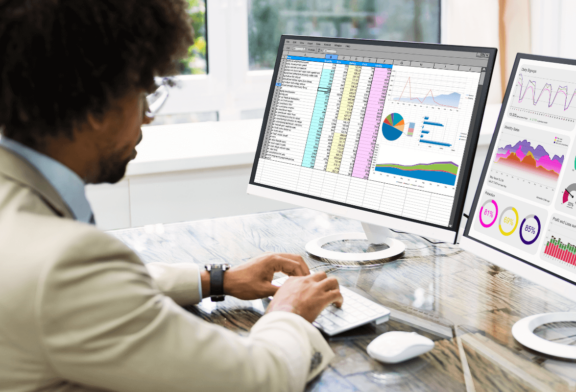Hybrid working is fast becoming the preferred work arrangement for leading companies. With employees eager to strike a healthy work life balance, a hybrid working arrangement can help develop the flexibility and autonomy they need to flourish.
This ultimate guide to hybrid working covers everything you need to implement a hybrid model. You’ll discover the basic principles of productivity, communication, and health, alongside the tools and processes necessary to make it work.
What is hybrid working?
Hybrid working offers employees a flexible working pattern that splits their time between the office and remote working.
Some companies were experimenting with the hybrid working arrangement prior to the COVID-19 pandemic. The huge increase in remote working during the pandemic lockdowns forced companies to reassess how a hybrid model could be achieved the most effectively.
By 2021, Microsoft was referring to hybrid working as the “next great disruption”. In an article discussing hybrid work in the post-pandemic world, they summarised the situation by saying, “The data is clear: extreme flexibility and hybrid work will define the post-pandemic workplace.”
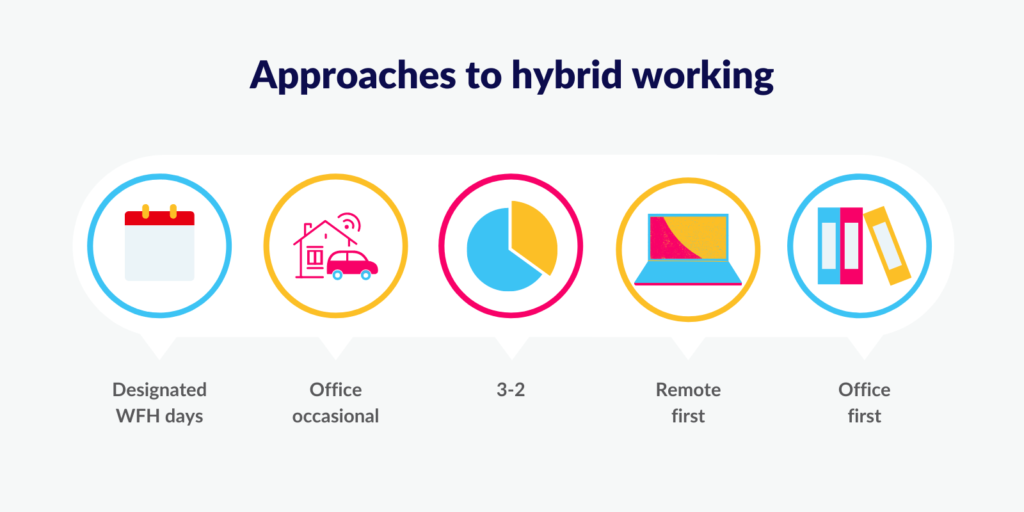
Fast forward to the present day and it’s clear that the flexible working model is here to stay. This approach can be implemented in a variety of methods, which we’ll run through briefly now.
Designated WFH days
Designated work from home days are allocated days of the week when an employee can work from home. These can be any weekdays that are deemed appropriate by the employee and their manager. They are usually agreed upon after discussion between all parties.
Office occasional
The office occasional approach to a hybrid working arrangement is more infrequent than designated WFH days. This could mean that an employee only comes into the office on a fortnightly, or even monthly, basis.
This arrangement can be set up so that these occasional workdays on-site are scheduled around project milestones, meetings with clients, or for team-building and knowledge sharing sessions.
Remote-first
As the name implies, the remote-first approach to hybrid work is a flexible working model that prioritises remote work as the primary mode of working. A crucial aspect of this approach is to ensure that meetings and other collaborative processes between employees includes remote workers.
This makes sure they are a part of any ongoing conversations and fosters a supportive company culture. To achieve this, companies can introduce processes for conducting meetings via video conferencing or online messaging tools.
3-2
The 3-2 model of hybrid working is structured so that an employee works three days per week in the office and two working remotely, or vice versa. It is designed to encourage a healthier work-life balance in companies where a fully-remote strategy isn’t feasible.
Before the pandemic, it was commonly used by employees with caregiving responsibilities to give them additional flexibility to manage their time. However, post-pandemic, it has become a more widely adopted approach, no matter an employee’s external responsibilities.
Office-first
This approach to a hybrid working arrangement places a priority on working at the office. Employees should, whenever possible, work alongside colleagues in the workplace, only working remotely occasionally and when it is appropriate to do so.
Hybrid working principles
Hybrid working poses a series of challenges that business leaders and managers don’t have to consider when their employees work exclusively on-site. Acknowledging and overcoming these challenges requires the right tools and processes in place.
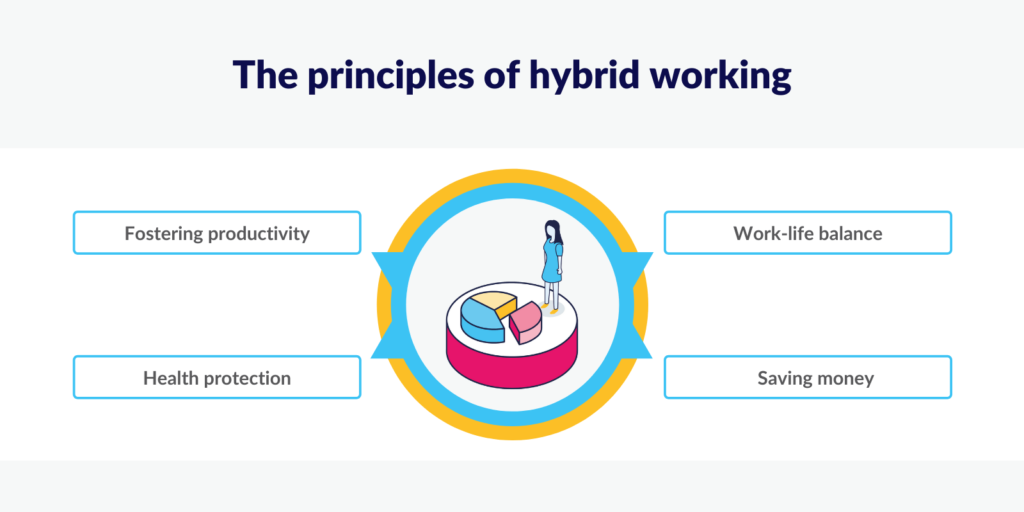
Fostering productivity
The hybrid work model requires organisations to redefine how they both encourage and measure productivity. Managers and team leaders are unable to have direct visibility over staff, so digital tools are required in order to keep track of progress towards goals.
This can be achieved by using real-time data to amp up employee productivity. Tracking progress towards objectives and key results, rather than in-the-moment observation, gives managers opportunities to deliver instant feedback. Performance management software can be used not only for tracking OKRs; it’s also a valuable tool for scheduling and conducting regular one2one check-ins to help keep employees motivated to succeed.
Work-life balance
Employees who are given the opportunity to adopt a flexible hybrid working arrangement are more likely to express higher satisfaction when assessing their work-life balance. This flexibility is intrinsically linked to autonomy, through which employees feel a much greater sense of agency over their own scheduling decisions.
An article from the Harvard Business Review summed up this desire for autonomy, saying:
“Maximizing employee autonomy is becoming less of a workplace benefit and more a necessary element to remaining competitive and relevant as an organization.”
This means providing the necessary tools and technology to allow employees to do their best work wherever they are, and a company culture that supports flexible working whenever possible.

Health protection
Recognising and addressing health issues in a timely manner is another challenge posed when employees work from home. A hybrid working model requires new protocols to help employees report health issues and, when appropriate, get the necessary support from their HR or occupational health department.
Saving money
An obvious advantage to hybrid working, for employers and employees alike, is the reduction in overheads and other related costs of working in an office. Employers can save on utility expenses, reducing the amount of electricity used for lighting and computer equipment, as well as potentially relocating to a smaller office space.
Employees save both time and money on their daily commutes and other expenses such as food and drinks. Additional potential costs such as outsourced childcare can also help employees cut costs over time.
Creating the best hybrid work environment
Creating an effective hybrid work environment requires establishing tools and approaches to work that treat on-site and remote workers equally. This can be achieved through the development of a strong company culture that understands the needs of workers, wherever they are. A simple way to embrace this is through a performance management system, which can be used to help connect everyone on a shared platform.
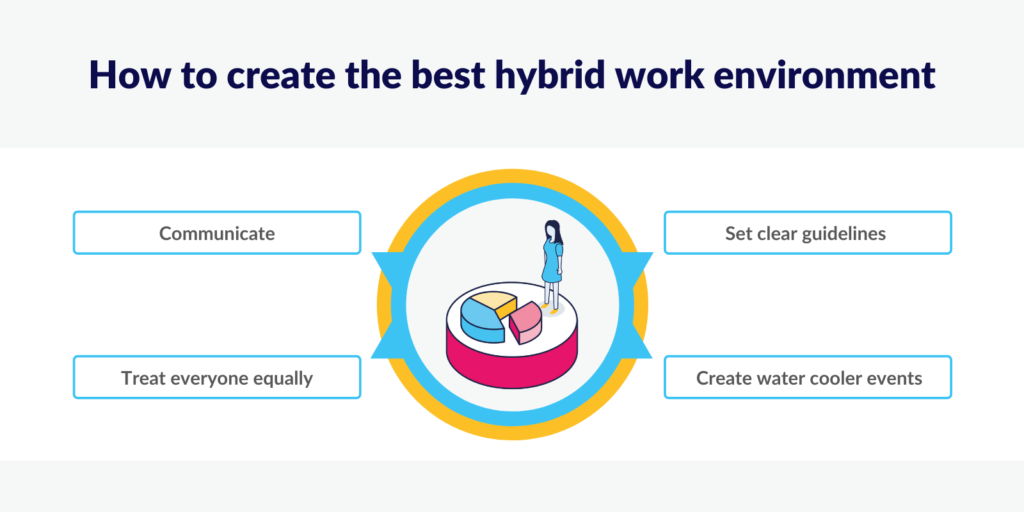
Communicate
The traditional email method of communication only goes so far when it comes to connecting businesses operating a hybrid working model. Employees working off-site aren’t always at their computers, so a multi-channel communications platform is an essential tool for a hybrid workforce.
Multi-channel communications allow users to send messages via:
- SMS/mobile phones
- Desktop and laptop devices
- Via the performance management software application
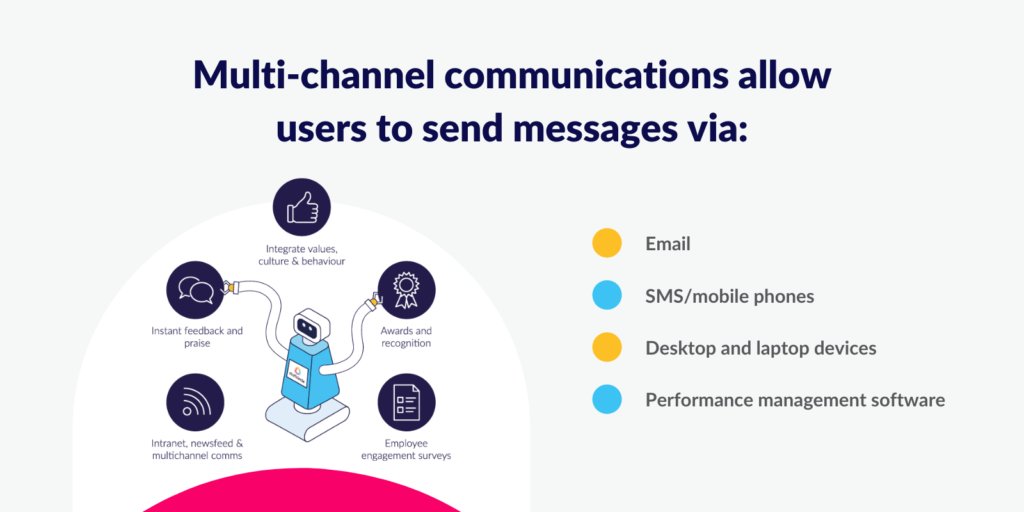
This approach to diverse communication methods also allows easier and faster contact with contractors, freelancers, and employees who spend much of their time away from their desks.
Embracing multi-channel communications opens up a range of additional communication methods that employees working on a hybrid model can take advantage of. These methods include:
- Conducting regular one2one check-ins with team leaders and managers. As we’ve touched on earlier, continuous conversations between managers and employees are crucial when operating a hybrid working environment. Performance management software includes scheduling tools, as well as meeting templates, to help keep these important conversations going.
- Connecting with colleagues via social intranets. With loneliness becoming a key concern in the post-pandemic world, helping remote workers connect and develop relationships with their peers is essential. Social intranets can be used to help strengthen bonds while giving employees a place to collaborate and engage with their colleagues.
- Engaging with peers through chat systems such as Microsoft Teams. More informal conversations can also be conducted through performance management software, with some tools allowing for the integration of Microsoft Teams to make this even easier.
Treat everyone equally
It goes without saying that businesses are ethically bound to treat everyone in the workplace equally. But it can be easy to overlook employees who are working remotely, simply because they aren’t present in the office when making decisions.
When implementing a hybrid working arrangement, make sure to be clear that all communications should be run through platforms that are shared by remote workers, so that they are always kept in the loop.
Set clear guidelines right from the start
An effective hybrid work model requires clarity on what is and isn’t expected from employees who participate. These can be stored on your company’s intranet so that everyone can access them easily.
Any new hire should be taken through this information as part of their onboarding process, while any updates made to the hybrid working guidelines should be clearly communicated to all parties via your communications platform.
Create water cooler events
The stereotypical focal point for casual conversations and networking, the water cooler ‘moment’ is an important concept for improving relationships and sharing ideas. When dealing with a hybrid workforce, steps should be taken to create virtual water cooler experiences for on- and off-site employees.
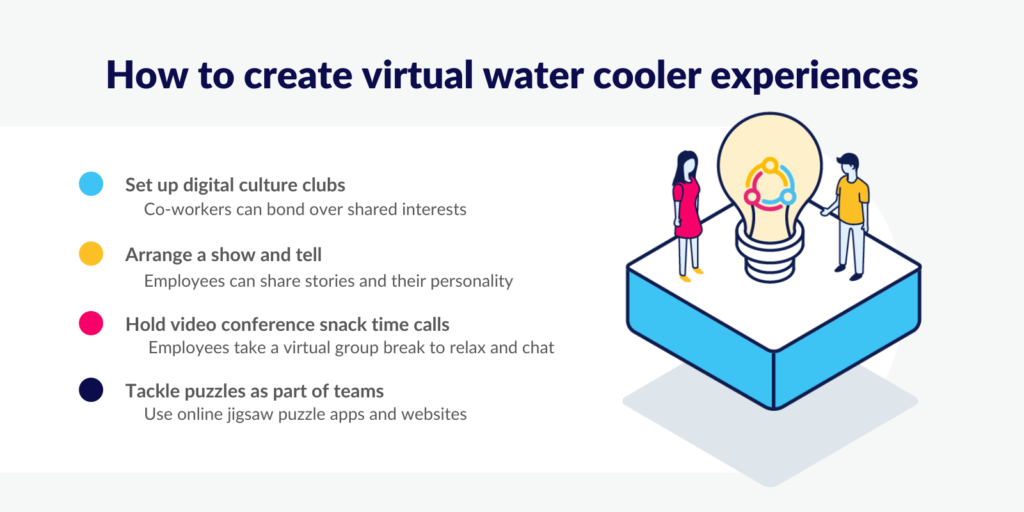
You can help reproduce the water cooler vibe in a variety of ways. For example:
- Set up digital culture clubs where co-workers can bond over shared interests
- Arrange a show and tell, giving employees an opportunity to share stories and their personality
- Hold video conference snack time calls, where all employees on a team take a virtual group break to relax and chat
- Tackle puzzles as part of teams, for example by using online jigsaw puzzle apps and websites
What is the difference between hybrid and work from home?
If you’re still unclear on the difference between hybrid work and work from home, here’s a quick recap.
Hybrid work occurs when an employee spends time working from both the office and remotely, usually from home. Hybrid workers can sometimes adopt a more flexible arrangement, whereby they work remotely from somewhere other than their home office.
Work from home occurs when an employee works exclusively from home, rarely visiting the office.
Do employees want hybrid work?
The desire for hybrid work varies depending on the demographic data, but one thing is clear; Gen Z is broadly in favour of hybrid working more than any other age group. A BBC interview with a Gen Z worker, Isabelle Lichtenstein, characterised the motive behind this desire for hybrid work arrangements:
“In my eyes, a hybrid model is one that allows workers to figure out what best works for them… The ideal hybrid work environment for me allows employees the flexibility to find what best serves how they work, and to implement that with the support and resources of their employer.”
While support for hybrid working is strongest in Gen Z workers, it also has considerable support for other demographic groups. With the most resistant group found in workers over 50 years old, it’s clear the long-term trends indicate a hybrid working model is one that an increasing number of companies are likely to adopt.
In Summary
With the increasing demand for flexibility and autonomy, implementing a hybrid working arrangement is becoming increasingly important if businesses wish to attract and retain the best talent.
This guide should help you to develop an effective hybrid work model that encourages productivity, communicates effectively, and supports employees’ work-life balance.





